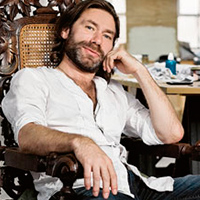 Matthew «Mat» Collishaw is a British artist, born in 1966 and based in London.
Matthew «Mat» Collishaw is a British artist, born in 1966 and based in London.
He received his BFA from Goldsmiths College, London, in 1989 and began his career exhibiting the acclaimed work Bullet Hole alongside his Goldsmiths contemporaries at the legendary show “Freeze” in 1989 and at “Modern Medicine” in 1990.
Both shows were curated by Collishaw’s long-term friend Damien Hirst and are renowned for the rise to prominence of the YBAs (Young British Artists).
Matt Collishaw’s art envelops us in a twilight world poised between the alluring and the revolting, the familiar and the shocking, the poetic and the morbid. With a visual language embracing diverse medi150 151 ums, Collishaw’s work draws us in – it is seductive, captivating, hypnotic – only to more forcefully repel us as we perceive the darker fantasies within. A repulsion that is triggered not by what we see, but by our innate response to it. Pornography, the crucifixion, gleaming fairies, syphilitic child prostitutes, bestiality, bondage, addiction, religion, exaltation and despair, even the final hours of a deathrow inmate-the forbidden has always fascinated Collishaw: “I am fuelled by things in my past which were suppressed or held at a distance, which have generated some form of hunger to make my work.” Hardly surprising then, such themes as stifled sexual desire, brutal and perverse lust, the power of media imagery, and the concept of divinity recur throughout his oeuvre.
What is surprising, even startling, is the tenderness and ecstasy to the point of the sublime that is embodied within the work.
“There are mechanisms within us that are primed to respond to all kinds of visual material,» the artist says, «leaving us with no real say over what we happen to find stimulating.” Collishaw is interested in imagery’s effect on the subliminal, and explores this by making the vile desirable and the repulsive inviting, while discretely positioning himself within art-history through his reference to Old Masters and contemporary dialogues, as in his work The End of Innocence (a digital recreation of Francis Bacon’s painting of Velasquez’s Pope Innocent X) or his questioning of Victorian morality and ideals, executed with 21st-century technology.
Collishaw’s interest in the Victorians is no coincidence: 19th-century Britain viewed itself enlightened by scientific progress and empirical soberness. It was an age inhabited by educated and prosaic people. In retrospect however, child prostitution, poverty, perversion, and a collective bloodlust ran parallel to what was deemed an enlightened age. Collishaw references the Victorian period by simulating its elaborately decorative, romantic style, but he indirectly conjures up that society’s dark side_the corrupt underbelly so pertinent to the present day. He drags our darkest urges into the light_illustrating that humans will never overcome their baser instincts, regardless of aesthetic or scientific advancement. The fact that Collishaw does not take the moral high ground makes his work all the more compelling_he simply shows us the beautiful_ even if it is a beauty that sometimes turns out to be highly suspect.
Over the past decade, his work has been exhibited in numerous solo shows around the world, including: Camden Arts Centre, London (1996); «Duty Free Spirits»Lisson Gallery, London (1997), Galeria d’Arte Moderne, Bologna, Italy (1999); Museum of Contemporary Art, Warsaw (2000); «Hysteria,» Freud Museum, London (2009); and «Retrospectre,» BFI Southbank, London (2010); Bass Museum of Art (2013).
Group exhibitions include: «Institute for Cultural Anxiety», ICA, London (1994); «Here and Now,» Serpentine Gallery, London and «Brilliant!» New Art From London, Walker Art Centre, Minneapolis (both 1995); «Sensations,» Royal Academy of Art, London (1996); «The Edge of Awareness,» P.S.I, New York (1998); «Life/ Live,» Musée d’Art Moderne de la Ville, Paris and The Brooklyn Museum, New York (1998); «New Blood,» Saatchi Gallery, London (2004); «In the Darkest Hour There May Be Light,» Serpentine Gallery, London (2006).
 FR
FR